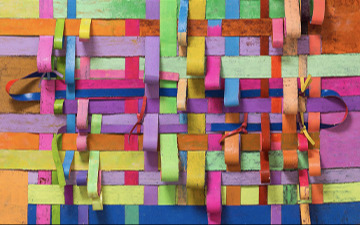
Solo Exhibition
Mit Jai Inn
106 New Oxford Street, WC1A 1HB, London, United Kingdom
About
“When I paint, it’s not only with my eyes, but with all of my senses: touch, smell, movement. The whole entity.” — Mit Jai Inn
APSARA Studio and Silverlens in collaboration with Ikon are thrilled to present the first solo exhibition in London by leading Thai artist Mit Jai Inn (b.1960, Chiang Mai). A renowned figure of contemporary art in Thailand, Mit is celebrated for his colourful artworks that merge painting and sculpture. Featuring works from his recent Dreamworld exhibition at Ikon Gallery, Birmingham, the three week show presents recent and new works made for Ikon which embody his vision of art “as a utopian dream within everyday life” and collective hopes for a brighter future.
As written by Ikon Curator Melanie Pocock: “A republican and activist, Mit’s works often convey his resistance to the Thai monarchy and military rule. Since 2020, popular protests in Thailand have called for political reform and for King Maha Vajiralongkorn to step down. Though punishable by imprisonment, thousands of people, including Mit, continue to campaign at their own risk, galvanised by the possibility of change. At times, colours in Mit’s works such as red, blue, yellow and silver reference Thai politics and his indigenous Yong heritage. Their defiance of traditional formats of painting also convey his rebellious spirit.
For Mit, painting is both intensely physical and deeply meditative. Using his hands, fingers and, occasionally, a palette knife, he dabs, slaps and pulls colours across the canvas, blending them intuitively. The thick consistency of his paints is derived from a mixture of old oil paint, gypsum powder, colour pigments and acrylic paints, loosened with linseed oil. Reflective minerals increase the dazzling effect of their combined colours and give them their “magic” glow.”
Stepping into the gallery space the visitor is invited to encounter Midlands Dwelling (2021), a site-specific work originally presented at Ikon that emphasises the textural physicality of Mit Jai Inn’s luminous practice as well as Scrolls (1987 –), which transform a traditional format of Eastern painting into rollable sculptures. Hanging on the walls is Patch Work 2, which breaks away from the clean lines and logic of minimalist painting through woven ribbons of canvas, while the fluorescent colours and frayed edges of Dream Works (1999 –) “express the excitement and anxiety felt by people around the world on the eve of the new millennium and since”.
The exhibition is accompanied by the London launch of Mit Jai Inn’s monograph, a comprehensive survey of Mit’s life and work, published by Ikon and ArtAsiaPacific Foundation, designed by Fraser Muggeridge studio. It includes full-colour documentation of the exhibition and key works, with texts by Melanie Pocock, Ikon Curator; art historian Simon Soon; critic and curator Brian Curtin; plus an interview with the artist by Gridthiya Gaweewong, Artistic Director, The Jim Thompson Art Center, Bangkok.
Mit Jai Inn's (b. 1960, Chiang Mai; lives and works in Chiang Mai, Thailand) paintings come into being in his outdoor Chiang Mai studio, where he gives turns to the vibrating spectrum of sun and moonlight, with nocturnal interludes under white fluorescent. His colour-based, densely layered work defies conventional boundaries of painting, while variously enacting its multiple histories and treatments.
Mit’s practice is, on the one hand, rooted in a rigorous physicality of both manual and optical labour. His studios’ multiple workstations show evidence of crushing and mixing colour of his own making, of plotting, pulling and pushing, overlaying, and scraping pigment. Canvases, often treated on both sides, stretch across floors, drape from tables and hang from metal beams. In place of brushes, mark makers are palette knives, hands, and fingers.
While this corporeality of colour is embedded and perceptible in Mit’s painted forms, it is also his way of actively channelling, resisting, or responding to particular aesthetic, social and political histories. These can include divisions between so-called ‘Western’ and ‘Eastern’ canonical painting to shifting political states in Thailand. Within each new body of work are offerings inspired by and made for the nations, spaces, hosts and publics of his often site-specific work. This accounts for evolutions in colour, scale, and topographical variation, from sombre amorphous blotches, bright grids, crafted pastel stripes, all-over dots in neon, and more.
